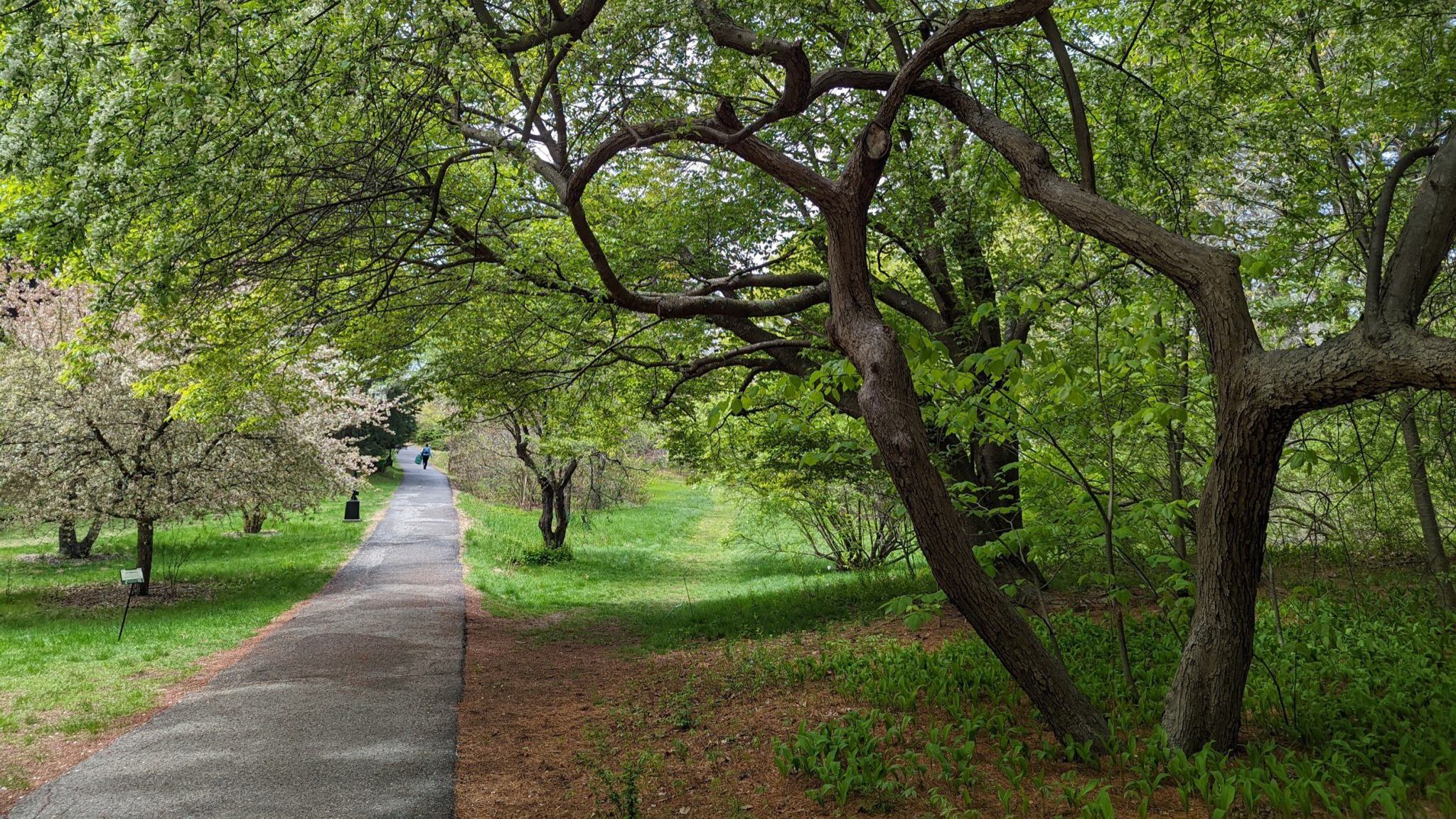Wellesley College Botanic Gardens features 22 acres of curated outdoor gardens, greenhouses, and landscapes within the beautiful and historic Wellesley College campus.
Learn about the gardens
The Wellesley College Botanic Gardens (WCBG) features thousands of accessioned plants representing over 1,500 different taxa from more than 150 different plant families, growing in diverse habitats and communities. The WCBG builds on the instinctive affinity for plants, nature, and harmonious landscapes through ecologically focused curation and maintenance. This focus on plants and landscapes contributes to increasing knowledge and opportunities for teaching and research at the College, and develops our empathy and care for plants and the natural world. Garden areas and exhibits have unique themes, while being unified in their underlying goals of educational value and engaging design.
View the sections below to learn about different garden areas.
Garden Areas
The Alexandra Botanic Garden features temperate-climate trees and shrubs from around the world, within a framework of towering oaks and pines, and a meandering mown path starting from Paramecium Pond and the bog garden.
The H. H. Hunnewell Arboretum spans diverse habitats, including a maple swamp, meadows, vernal pool, and fragments of different forest types, with primarily native species.
Our innovative Edible Ecosystem Teaching Garden is a dynamic edible forest garden, and includes experimental plantings, and the popular Outdoor Garden Classroom gathering space.
Specialized gardens include a conifer garden , pollinator garden, experimental gardens, and more!
The Margaret C. Ferguson Greenhouses brings Ferguson's vision of “laboratories under glass” into the 21st century:
The Global Flora conservatory highlights beauty and diversity in plant form, and our global connections with plants across cultures. Global Flora also serves as a new node for interdisciplinary learning and an innovative example of sustainable design, with live-streaming climate sensors, rain-fed irrigation, and reduced heat consumption. Global Flora is open to the public, with free tours and group reservations available, during staffed hours throughout the year.
The Annex, a small greenhouse built in 1906, has been restored and is a free plant swap and potting area, located just outside of the Visitor Center, and open for all.
The Teaching and Research Greenhouses are connected to the Science Center and the recently launched Frost Center for the Environment, and support student and faculty research, teaching, and other programs. These greenhouses are subdivided into three research spaces, a large teaching greenhouse, and a headhouse for class use. These are not open for visitation.
The Botanic Gardens Visitor Center is a reception area for visitors, a gathering space for tour groups, and classroom space for campus and public programs. The Friends of Botanic Gardens office is located here. The central multi-purpose room is named for Harriet B. Creighton, Professor of Botany from 1940-1974. The Visitor Center was built in 1992 through generous donations from Wellesley alums and the Friends of Botanic Gardens. The structure's design closely mimics the design of the old Ferguson Greenhouses. Visitors can find educational materials, maps, and chat with student, staff, or volunteers at the front desk during staffed open hours.
The Wellesley College Botanic Gardens' Visitor Center is a reception area for visitors, a gathering space for tour groups, and classroom space for campus and public programs. The Friends of Botanic Gardens office is located here. The large meeting room is named for Harriet B. Creighton, Professor of Botany from 1940-1974. The Visitor Center was built in 1992 through generous donations from Wellesley alumnae and the Friends of Horticulture, as the organization was then known. The structure's design closely mimics the design of the old Ferguson Greenhouses. Visitors can find educational materials, maps, and ask for guidance from student, staff, or volunteers at the front desk during Visitor Center open hours.
Search our Garden Explorer map database for Global Flora plants:
https://wellesley.gardenexplorer.org/default.aspx
This currently includes select accessioned plants in Global Flora and the Edible Ecosystem.
There is additional information on Edible Ecosystem plants on our website, including a student-made interactive map of seasonable edible plants.
Search our outdoor gardens plant database:
Use this digital map and select plants or use the search feature to display details.
Outdoor garden plant accessions - This is our past searchable database. An updated tree and shrubs inventory of the outdoor Botanic Gardens was completed in Aug 2022, and is available in our digital map.
Looking for Class Trees?
Class Trees are mapped on this interactive project from the Paulson Initiative, by Kristine Meader '21. Note that most class trees are not planted within the Botanic Gardens; please contact Wellesley Facilities - Grounds department for inquiries about specific class trees.
Look at our Garden subpages for additional plant lists, or contact us with specific questions.
We acknowledge that Wellesley College is built on ancestral and traditional land of the Massachusett people. We also recognize that the United States’ removal, termination, and assimilation policies and practices resulted in the forced settlement of Indigenous lands and the attempted erasure of Indigenous cultures and languages. We further acknowledge the oppression, injustices, and discrimination that Indigenous people have endured and that there is much work to be done on the important journey to reconciliation. We commit to strengthen our understanding of the history and contemporary lives of Indigenous peoples and to steward this land.
We further recognize the many Indigenous people living here today—including the Massachusett, Wampanoag, and Nipmuc nations—who have rich ancestral histories in Wellesley and its surrounding communities. Today, their descendants remind us that they are still here, where they maintain a vital and visible presence. We honor and respect the enduring relationship between these peoples and this land, as well as the strength of Indigenous culture and knowledge, the continued existence of tribal sovereignty, and the principle of tribal self-determination.
We thank the Native American Student Association at Wellesley College for their support in developing this land acknowledgement, and we are committed to supporting continued action and advocacy.
